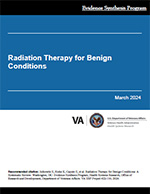
|
Recommended citation: |
Download PDF: Complete Report, Executive Summary, Report, Appendices
Forty-eight studies reported on the effectiveness of low-dose radiation therapy (RT) for 9 prioritized diseases: heterotopic ossification, keloids, plantar fasciitis, pterygium, osteoarthritis, Dupuytren's contracture, Ledderhose disease, Peyronie's disease, and hidradenitis suppurativa. RT may reduce heterotopic ossification and improve function in plantar fasciitis. There was no significant difference in pain for keloids. Although studies provided insufficient evidence for most outcomes, there is no indication that RT should not be used after conventional therapy fails.
Low-dose radiation therapy (RT) has been proposed as a treatment for benign inflammatory and degenerative musculoskeletal disease after conventional therapy fails. Outside of Germany, RT is rarely used to treat benign diseases. In this review, we synthesize the evidence on the effectiveness of RT for 9 prioritized diseases: heterotopic ossification, keloids, plantar fasciitis, pterygium, osteoarthritis, Ledderhose disease, Dupuytren's contracture, Peyronie's disease, and hidradenitis suppurativa.
Forty-eight studies reported on the effectiveness of low-dose radiation therapy (RT) for 9 prioritized diseases: heterotopic ossification (10 randomized controlled trials [RCT]), keloids (4 RCTs and 2 nonrandomized comparative studies [NRCS]), plantar fasciitis (2 RCTs, 1 NRCS, and 2 single group studies), pterygium (2 RCTs, 2 NRCS and 2 single group), osteoarthritis (2 RCTs, 3 single group and 1 systematic review), Peyronie's disease (5 single group), Dupuytren's contracture (5 single group), Ledderhose disease (1 RCT and 3 single group), and hidradenitis suppurativa (1 single group). RT may reduce the occurrence of heterotopic ossification and improve function for people with plantar fasciitis. There was no difference in function for heterotopic ossification, pain for keloids, or plantar fasciitis thickness and a composite of pain and function in plantar fasciitis. Single group studies mostly reported symptoms improved after RT, but this design is unable to estimate the casual effect of RT on outcomes.